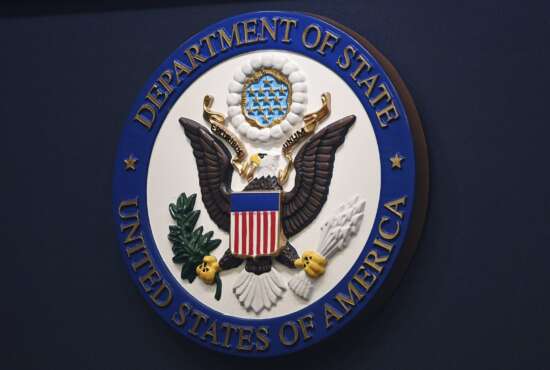With new AI tools available, State Department encourages experimentation
State wants employees to try out new AI tools like State Chat and North Star, but also share their own use cases to help drive the agency's AI approach.
The State Department is launching a new artificial intelligence hub and encouraging employees across the globe to experiment with AI technology in ways that help streamline their diplomatic work.
Secretary of State Antony Blinken announced “AI.State” as a “central hub for all things AI” for the department’s 80,000 employees.
“It offers formal and informal training, including videos that are up there to help folks get started,” Blinken said during an event at the State Department today. “It’s a home for all of our internal State Department AI tools, libraries of prompts and use cases. And I would just say, try it out. I’d encourage everyone to test it out, to try it out, to explore it, to try to learn from it. And also lend your own ideas and input because this is something that will continue to be iterative and a work in progress.”
The State Department last fall released an enterprise AI strategy. The strategy prioritizes an “AI-ready workforce.” The agency has also been exploring using generative AI to help employees plan their next career steps.
Blinken said a big motivation for the State Department’s use of AI is improving analysis, while also freeing up its employees to work on high-priority tasks.
“We can automate simple, routine tasks,” Blinken said. “We can summarize and translate research. Something that would take normally days, even weeks, can be done in a matter of seconds.”
Blinken and other State officials at the event today encouraged the workforce to not just experiment with AI, but share use cases to better inform the agency’s approach to the technology.
“If that particular solution isn’t shared, if it just stays with that one person, that one group and that one country or that one place, then you have this reinvention of the wheel that has to go on time and time again,” Blinken said. “Our ability to draw from the experience that all of our teams are going to have using, deploying, experimenting with AI all around the world, but then bringing it back and having these use cases – especially the ones that are producing really interesting new things –come to the top, but then be taken and shared across the enterprise.”
State’s AI ‘North Star’
Earlier this spring, the State Department rolled out a new AI tool called “North Star” that can analyze and summarize news stories in more than 200 countries and in over 100 languages. Matthew Graviss, the State Department’s chief data and AI officer, said the agency’s public diplomacy officers are already making use of the tool.
“The ability to summarize in the media space, and then use that time that you saved to call the reporter find out a little more context around why they wrote that article, maybe shape the next article,” Graviss said today. “It’s repurposing that time to the higher value asks that we want our experts in diplomacy doing.”
Elizabeth Allen, under secretary for public diplomacy and public affairs, estimated the media monitoring tool could save PD officers 180,000 hours over the next year. “We have a lot of opportunity in the communication space to use AI,” Allen said today.
But she added that State’s public affairs offices also need to ensure that people are ultimately reviewing any outputs from generative AI, particularly if it helps feed prepared remarks made by ambassadors.
“We always have to be making sure that we have human checks, particularly when it comes to public communications,” Allen said.
The State Department also recently released a chatbot, “State Chat.” Graviss said his team can analyze the prompts and tweak the tool accordingly.
Kelly Fletcher, State’s chief information officer, said the department’s cybersecurity specialists are also “red teaming” any new enterprise tools like State Chat.
“We do that with almost all of our platforms and systems,” Fletcher said. “In the case of the newest AI technology, we were testing it . . . we found some stuff. Honestly, these folks managed to do some really cool sneaky things. And they were able to see what some folks’ prompts were, they were able to see information they shouldn’t have been able to see, and we fixed it.”
She said training is mandatory to use any new AI tools. And State’s IT teams are also monitoring tools like State Chat for nefarious activity.
“We can see what prompts people are using, not just to inform how is this technology being used and how is innovation happening in the field, but also we can see if somebody’s up to no good,” Fletcher said. “Whether they’re a person who works at the State Department, or somebody who’s managed to get in and is pretending to be a person who works at the State Department.”
Meanwhile, Uzra Zeya, under secretary for civilian security, democracy and human rights, said her team launched an AI research assistant called “data collection management tool,” DCT, in February 2023. Zeya said the tool will reduce by one-third – 52,000 hours per year – the time her officers spend researching and fact-checking reports.
The DCT capability is now available through AI.State.
“I’m really proud of what we’ve been able to accomplish, and I think this is an example of technology supporting not supplanting our work,” Zeya said.
Blinken said he believes AI will be fully integrated into the State Department’s work within the next 10 years.
“Some of this entails experimentation, some of it entails risk,” Blinken said. “But if we’re not leaning in, we’re going to be left out and left behind.”
Copyright © 2024 Federal News Network. All rights reserved. This website is not intended for users located within the European Economic Area.
Follow @jdoubledayWFED




